Towards the end of last year
we brought you
the news of two new 27" models which were in production by Hazro. These new
models would form part of their new range of IPS screens, and follow on from the
updated 30" HZ30Wi and HZ30Wi-Q models. We took an in depth look at the 30"
HZ30Wi back at the beginning of October last year and we were impressed by its
performance and its excellent price point. In December we also had chance to
test and review the first of the two completed 27" models, the
HZ27WB. This screen used a wide colour gamut CCFL backlight unit and offered
a cost effective alternative to
Dell's popular U2711 screen. The screen did lack some of the advanced
features and extras of the Dell U2711 of course but was a more basic 'no frills'
screen with a great spec, some very nice performance and a very low price point.
Now we have an exclusive first look at the brand new HZ27WA, Hazro's second
27" model which is to be released imminently to the market. Hazro tell us
that it is expected to be available within the next couple of weeks. This new
screen is already attracting a lot of pre-release
interest. The reason for this is its very similar spec to Apple's 27" Cinema
Display featuring the same LG.Display H-IPS panel, a W-LED backlighting unit, standard gamut
and even a glossy screen coating. The HZ27WA is really the only
alternative to the Apple Cinema Display with the same type of features so it is
bound to attract a lot of interest. Rather than being aimed at professional
graphics users it is more aimed at general and multimedia use. There will
actually be two versions of this model as well with different interface options.
We have tested both version. There is the HZ27WA which features a decent
range of connections including Dual-link DVI, HDMI, 2x VGA and component. The
other version, which will cost a little less, is the HZ27WC
and will be the same screen, but with only a dual-link DVI connection. We will
discuss this a little more later.
-------------------------------------------
Update 7/11/12 - Important Note - Since this review was published there have
been further versions of the HZ27WA/C model released although fundamentally the
screen and panel remain the same. Hazro have released glass-free versions of the
monitor to some retailers, mostly due to user feedback about dust becoming
trapped behind the glass on the "regular" versions. A new HZ27WD model has also
been introduced which ultimately replaces the HZ27WA model.
It has been brought to our attention that a number
of buyers of the glass fronted version of these screens have experienced
problems with the glass front becoming disconnected, slipping in position or
completely falling off in some cases. This could present a safety concern,
especially where screens are wall-mounted or used by children. We feel it is
only right to reference this report in the review so that potential buyers have
the full picture. This issue has not affected all samples of the HZ27WA/C/D
monitor, but there have been numerous reports of disconnected glass. It seems in
many cases the glass may only be held on by double sided tape. We would advise
caution when considering a purchase of the glass fronted versions of these
screens while this issues is investigated by Hazro.
------------------------------------
Let's start by taking a look at the specs for the
HZ27WA / HZ27WC:
|
Size |
27"WS |
Colour Depth |
A = 1.07 billion colour (8-bit + AFRC)
C = 16.7m colours (8-bit) |
|
Aspect Ratio |
16:9 |
Colour Gamut |
Standard gamut = 77% NTSC, 77.2% Adobe RGB,
99.9% sRGB |
|
Resolution |
2560 x 1440 |
Backlight |
White-LED (W-LED) |
|
Response Time |
6ms G2G |
Panel Technology |
H-IPS |
|
Contrast Ratio |
1000:1 static
(with 1 million:1 DCR on HZ27WA only) |
Panel Manufacturer |
LG.Display |
|
Brightness |
420 |
Interfaces |
A = Dual-link DVI (HDCP), HDMI, 2x D-sub, 1x
component
C = Dual-link DVI (HDCP) only |
|
Viewing Angles |
178/178 |
Design Colour |
Black glossy plastic bezel and stand with
silver panel trim. |
|
Special Features |
Tilt adjustment only, 2x 5W integrated
speakers, glossy glass panel coating. PiP and aspect ratio control support
on HZ27WA only |
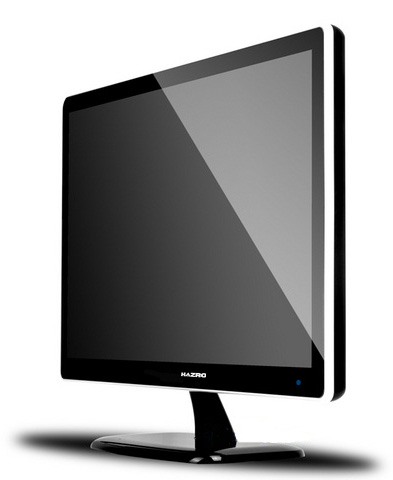
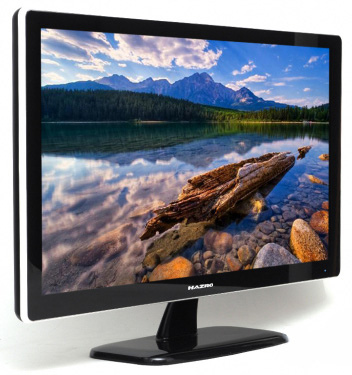
Above: views of the front of the screen from an angle.
The screen is an all black design with a
minimalist silver coloured trim around the front bezel as you can see from the
images here. The bezel around the panel measures about 23mm along the top and
sides, and is a little thicker at ~33mm along the bottom. The whole front of the
screen, including the bezel, is covered by the glass protective sheet, which
gives an attractive appearance and is very similar to Apple's 27" Cinema
Display. While the pre-release model I had for testing was missing the Hazro
branding logo, the final release will feature a small silver logo in the middle
of the bottom bezel, again like Apple's screen. There is a small subtle LED in
the bottom right hand corner which glows blue during normal operation,
and red in standby.
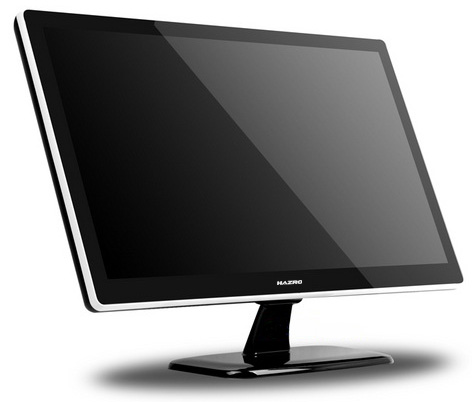
Above: The HZ27WA with a glossy panel coating and stand.
Hazro have reverted to a plastic enclosure and
stand for this model due to the cost of the aluminium designs they have used for
the
HZ30Wi and
HZ27WB, and their desire to keep final retail costs down. This
doesn't detract from the appearance of the screen at all though, since the front has
this nice glossy appearance from the glass coating, and high quality materials
have been used throughout. The stand is a glossy black plastic as well which
goes with the overall feel of the glossy panel.
The dimensions of the screen are (in millimetres)
654 (W) x 479 (H) x 180 (D) with the stand, and 654 (W) x 461 (H) x 81 (D)
without it. The height measurement on this "without stand" spec actually
includes the stump at the base of the screen, just not the plastic stand base. I
have measured the height of the panel only and found that to be ~ 403mm (H). The screen itself weighs 8.5 Kg maximum and the package overall is
10.5 Kg max.


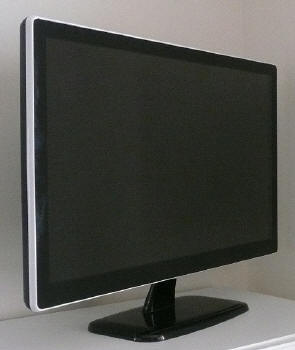
Above: side views of the screen showing range of tilt. Click for larger versions
There are limited ergonomic adjustments available
from this model, with only a basic tilt function available. This offers a decent
range of adjustment but is a little stiff to use. Once you have it set to
a comfortable angle then you are fine of course. There is no height adjustment
from the stand unfortunately which is missed. However, the screen is VESA 100 x
100 compatible and Hazro have told us that a separate stand or monitor arm will
be available to buy if required which will add further functionality. This extra
stand is expected to retail for around £30 - 40 we are told.
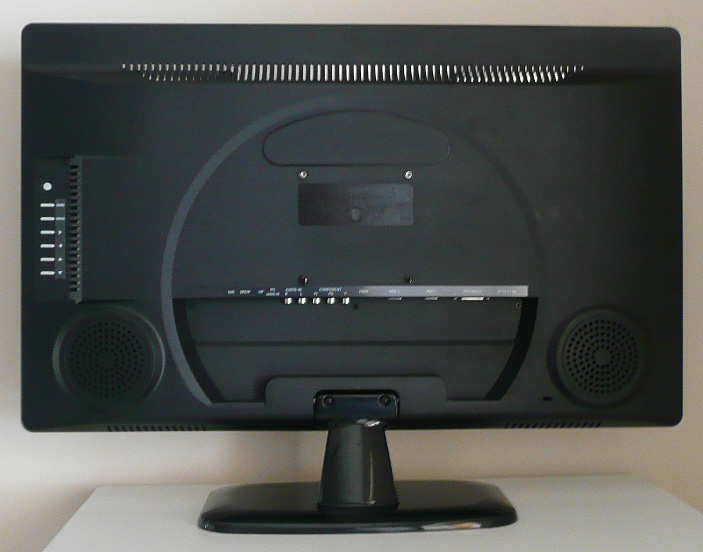
Above: back view of the HZ27WA
The back of the screen is a matte black plastic
colour and is pretty rounded and well enclosed. The OSD operational buttons are
located on the right hand side of the screen (left hand on this image above). On
the HZ27WC these buttons are labelled slightly differently but look the same.
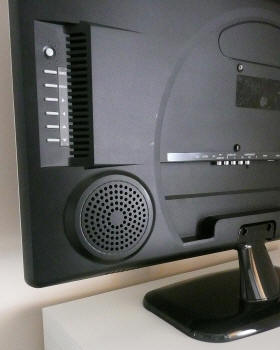
Above: back view of the screen showing OSD buttons and speakers. Click for
larger version
There are 2x stereo
integrated 5W speakers included as well which you can see on the bottom of the
screen, which accept sound either from the HDMI
input or from the stereo audio input (connected to your PC).

Above: back view of the HZ27WA showing range of interface options. Click for
larger version
The back of the screen features connections for
Dual-link DVI, HDMI, two D-sub VGA connections and component. There are also
SPDIF and PC audio inputs. There is a
connection for the external power supply which is a reasonably big power brick.
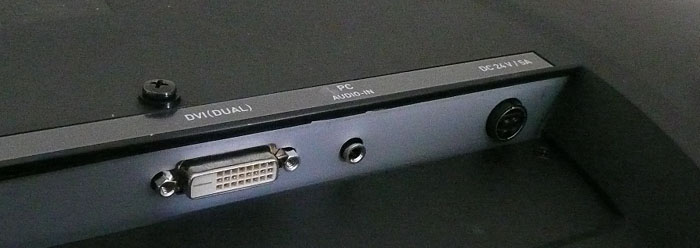
Above: back view of the HZ27WC showing DVI, audio and power connections only
The HZ27WC (same screen, DVI-only) will only offer a Dual-link DVI interface,
but will retail for a little less as a result. You may notice there is a USB
port labelled as "SVC" here, but this is not a useable USB port, and is used for
servicing by the manufacturer.
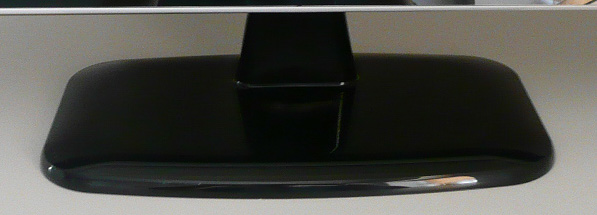
Above: view of the glossy black plastic stand
The screen is packaged in a pretty small box and
is easy to assemble. The base of the stand is detached but is easily fastened in
place with the two provided screws. The screen comes packaged with 1x DL-DVI
cable, 1x VGA cable, 1x HDMI cable, 1x stereo audio cable and the external power supply unit.
The HZ27WC (DVI only version) will come packaged
with just the DL-DVI and stereo audio cables.


Above: The Hazro HZ27WA next to Apple's 27" Cinema Display
The panel itself has a very nice 'feel' to it with
this glossy coating, and it helped give a sharp and vivid image I thought and
was very nice to look at. It did produce some extra reflections of course in
certain lighting conditions, and this could be an issue if you have a window or
light source behind you when you work. Screen coating is down to personal taste
of course but some people have found the aggressive AG (anti-glare) coating of
the recent IPS screens to be an issue. If you've ever seen an Apple display in
store in person, you will know what to expect here.
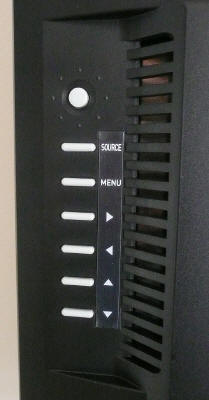
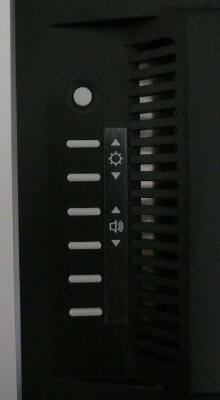
Above: back view of the screen showing OSD buttons of the HZ27WA (left) and
HZ27WC (right). Click for larger version
The OSD operation buttons are located on the back
right hand side of the screen. As such, they are pretty tricky to use at first,
but you soon get used to them. On the HZ27WA there is quick access to select the input, and
the right/left arrow buttons give quick access to the volume control for the
speakers. These pop up a confirmation message on the screen as well. The HZ27WC
model does not have an actual OSD and so the buttons control only power on/off,
backlight up/down and volume up/down. No messages are displayed on the screen
when you make these changes but the power LED blinks to confirm you have made a
change. You can obviously also see and hear the change in brightness and volume
respectively as you make those changes. On the HZ27WC the bottom two buttons are
there, but do not function.
After using these buttons for a little while you
do become accustomed to where they are, and you can feel your way to identify
which is which without too much trouble. They are more difficult to use than if
they were easily accessible on the front or side of the screen, but this has
presumably been done to create the minimalist feel of the screen. At least the
HZ27WA model features an OSD
menu though, as there isn't one on the Apple 27" Cinema Display! The HZ27WC
has more limited controls but useful at least to include backlight control and
volume there.
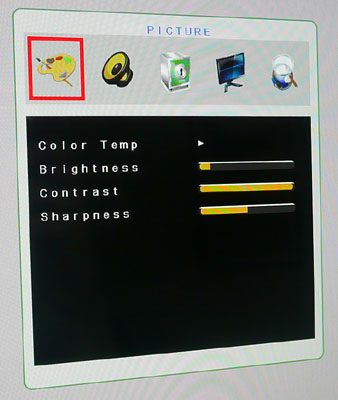
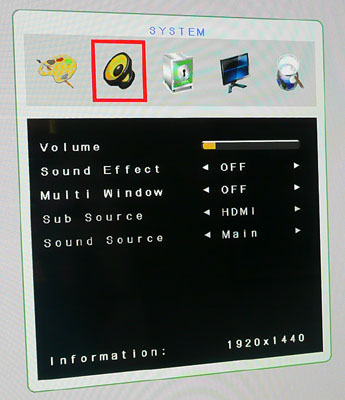
Above: OSD menus shown in the picture and system sections Only available on the
HZ27WA
Looking at the HZ27WA for a moment, the OSD itself is reasonable but a little limited
compared with some models like the Dell U2711 for instance. As we've said
already, at least one is included here and there's enough options to allow for a
decent level of control over the hardware settings. You will notice that the
images of the OSD are taken at a slight angle, and this is only to avoid
reflections of the camera when I took them. The picture menu gives you access to
the colour preset modes which has options for normal (default), warm, cool and
user. The user menu allows you to control the red, green and blue channels
individually, something which we will use during calibration. These RGB controls
are greyed out in the other preset modes. You also have access to the brightness
and contrast controls in this menu. We will talk about this much more in our
calibration section, but
the brightness control in this sub-menu is actually a digital white level
control. Thankfully there is still a control of the backlight intensity through
the 'ECO mode' setting (a normal 'brightness' control) in the other 'misc'
sub-menu. The 'system' sub-menu shown here gives you access to the options for
the audio and speakers, along with the PiP support through the 'multi window'
option. You may notice that there is a slight bug with the firmware here which
reports our resolution is 1920 x 1440, when in fact we are running at the native
2560 x 1440. I expect this will be fixed with the final release.
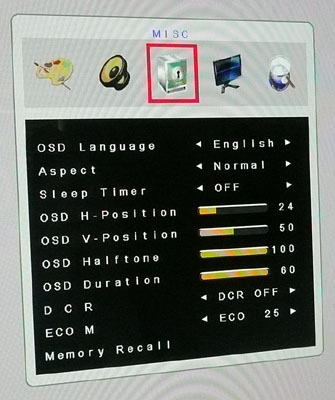
The 'Misc' menu gives you access to a few nice
extra features. There are options for
aspect ratio control which we will look at later and an option to turn the
dynamic contrast ratio
(DCR) on or off. It is in this sub-menu that you have access to the 'ECO mode'
which is actually a control over the screens backlight intensity. You can
control this in steps of 25% between 0 and 100, giving you control over the
luminance of the screen properly, along with the associated power savings which
can be made. You will notice also the other two sub-menu icons here. The menu
with the globe icon was actually part of the OSD software when it was used for
an alternative model in Asia where a Digital TV tuner was incorporated. Since this is
not included on the HZ27WA this section of the OSD menu will probably be removed
in the final version. The monitor icon has a sub-menu which is available when
you are using the D-sub analogue interfaces. There are options for clock, phase
etc in there.
As we've already mentioned, the HZ27WC (DVI-only model) will not feature an OSD menu and will
only offer 5 useable buttons controlling
on
/ off, backlight up / down and volume up / down.
|
HZ27WA

HZ27WC |
|
HZ27WA State |
Power Usage
(W) |
|
Factory Default |
57.1 |
|
Calibrated Settings |
49.1 |
|
Standby |
4.0 |
|
|
HZ27WC State |
Power Usage (W) |
|
Max brightness |
72.5 |
|
Calibrated Settings |
43.6 |
|
Standby |
3.4 |
|
HZ27WA - We tested the screen at factory settings and
once calibrated (see
calibration section). At default brightness (50% ECO mode) setting the screen used a
reasonable 57.1W of power but
this was reduced a little to 49.1W once calibrated, and the ECO mode
(backlight intensity)
setting was reduced to 25%. In standby the screen
uses only 4.0W of power. The top of the plastic gets a little warm during
extended use, but the front of the screen does not give off much heat
thankfully. There is a slight electronic buzz from the panel if you listen up
very close but not something you would notice in normal use.
HZ27WC - We tested the screen at the
maximum brightness control which used 72.5W of power. Once calibrated we had
reverted to setting level 2 (see our contrast stability section for
explanation) which resulted in a reduced power consumption of 43.6W, slightly
less in fact that the calibrated setting of the HZ27WA. During standby the screen used only
3.4W of power.
It should be noted that the sample we tested was
slightly ahead of the official release of the screen so there will be a couple
of minor aesthetic changes made when it ships to customers including a couple
of screws and there will be some Hazro logos on the screen. Apart from that there
shouldn't be any difference.

A note about warranties and
support – I have received some emails and read online about some
difficulties some buyers have had with the after-sales support from Hazro with
their original launch screens. There have been some complaints online about
lack of contact, warranty repair issues etc. I wanted to acknowledge that
briefly here, as while we are mainly interested in the performance of the
screens we test, we do know it can be a concern to potential buyers. Hazro are
obviously a smaller company than the Dell’s and HP’s of this World so it's
right to be a little cautious, but I have
spoken to their representatives about the warranty and support customers can
expect to receive from these new screens to which they have responded:
“Whilst Hazro as a brand remains as is, the company was
reformed. Hazro is now operated by new management and whilst our warranty
policy hasn't changed much, it will be strictly enforced by internal support
staff [as opposed to outsourced warranty providers who were used previously].
It is important to note that all new Hazro monitors are manufactured and
assembled in the UK so we have better control of the entire manufacturing
process. Consumer sales account for 5% of our turnover; yet all consumer
warranties will be handled by the same system used to manage business SLAs. A
press-release will be prepared at some point outlining what exactly has been
going on over the past 16 months. Full warranty details for the new screens
will be available on the website soon for those needing specifics.”

Colour
Accuracy, Black Depth and Contrast
The Panel and Backlighting Unit
I wanted to explain the differences between the
two 27" Hazro models here and talk a little about their "10-bit colour support".
The HZ27WB CCFL model offered a "10-bit" panel as you will be aware from
our
review. The HZ27WB can take a 10-bit input and, like the majority of so-called
"10-bit displays", it has a Frame Rate Control stage at the panel level which
gives that support. It isn't a 'true' 10-bit panel, and there are actually very
few models which offer this (e.g. the very expensive HP LP2480zx does), so this
is not uncommon. Instead the panel is actually an 8-bit + AFRC module
(LG.Display
LM270WQ2). The HZ27WB supports 10-bit input through this FRC at the panel
level. This is the same as NEC's 10-bit displays and the Dell U series which
support 1.07 billion colours.
You may notice that the HZ27WA also quotes a
colour depth of 1.07 billion colours in Hazro's spec. The screen actually utilises an
8-bit LG.Display
H-IPS (LM270WQ1) panel and is capable of producing 16.7 million colours. While
the panel does not offer an additional FRC for processing 10-bit sources, this
has instead been applied at a controller board level through the use of the two
scalers in this model. A 10-bit input would be processed on the scaler side with
an 8-bit+AFRC support, but the panel is actually a native 8-bit module. Some
other manufacturers, like Eizo for instance, use processes like this to offer
"10-bit support" for screens using 8-bit panels. Both manufacturers have
commented to us in the past that the end result is pretty comparable in practice
really. The difference with the DVI-only edition of the screen (HZ27WC) is that
it does not feature the scaler and so cannot offer this additional FRC stage.
That model is a standard 8-bit model only offering 16.7 million colour support.
Regardless of how the manufacturers are providing
this 10-bit support, you need to take into account whether this is
practically useable and whether you're ever going to truly use that
colour depth. There is a requirement of your application, operating system,
graphics card and software to support a 10-bit colour depth, not just your
display. A full 10-bit work flow is
still extremely uncommon in the current market so don't get too bogged
down with the marketing around 10-bit at this stage.
According to the spec the
screen can offer a colour gamut covering approximately 72% of the NTSC colour
space as it uses
White-LED (W-LED)
backlighting. This colour space is approximately the same as the sRGB reference
but is less than modern wide gamut screens of course. In fact if you study the
precise coordinates of the panel used from LG.Display's datasheet, the screen
covers 77% of the NTSC colour space and 99.9% of the sRGB gamut.
Testing Methodology
An
important thing to consider for most users is how a screen will perform out of
the box and with some basic manual adjustments. Since most users won't have
access to hardware colorimeter tools, it is important to understand how the
screen is going to perform in terms of colour accuracy for the average user.
I
restored my graphics card to default settings and disabled any previously active
ICC profiles and gamma corrections. The screen was tested at default factory settings using the DVI interface, and analysed using
an
X-rite i1 Pro spectrophotometer combined with
LaCie's Blue Eye Pro software suite. An NEC-branded and customised i1 Display 2 colorimeter was
also used to verify the black point and contrast ratio since the i1 Pro is less
reliable at the darker end.
Targets for these tests are as follows:
-
CIE Diagram - validates the colour space covered by the monitors
backlighting with the black triangle representing the display
-
Gamma - we aim for 2.2 which is the default for computer monitors
-
Colour temperature / white point - we aim for 6500k which is the
temperature of daylight
-
Luminance - we aim for 120
cd/m2, which
is the recommended luminance for LCD monitors in normal lighting conditions
-
Black depth - we aim for as low as
possible to maximise shadow detail and to offer us the best contrast ratio
-
Contrast ratio - we aim for as high
as possible. Any dynamic contrast ratio controls are turned off here if
present
-
dE average / maximum - as low as
possible.
If DeltaE
>3, the color displayed is significantly different from the theoretical one,
meaning that the difference will be perceptible to the viewer. If DeltaE <2,
LaCie considers the calibration a success; there remains a slight difference,
but it is barely undetectable. If DeltaE < 1, the color fidelity is excellent.
We will test both the HZ27WA and HZ27WC in turn.
Let's start with the HZ27WA.
Default settings of the screen were as follows:
|
Monitor OSD Option |
Default Settings |
|
Brightness |
50 |
|
Contrast |
50 |
|
Colour Temp |
Normal |
|
ECO Mode |
50 |

Hazro HZ27WA
- Default Factory Settings


|
|
Default Settings |
|
Luminance (cd/m2) |
153 |
|
Black Point (cd/m2) |
0.52 |
|
Contrast Ratio |
297:1 |
Out of the box the screen did feel a little bright
and while the colours felt even, they were perhaps a little washed out in
appearance. Blacks also appeared quite grey and not very deep. I
tested the screen in default mode with the i1 Pro and LaCie's software package.
On the left you can see a
CIE diagram representing the colour space which can be covered by this
screen with its W-LED backlighting. The black triangle represents the monitors
colour space, with the orange triangle being the sRGB reference space. As you
can see, the monitor covers this space well, extending a little beyond it in
fact along the edges.
Default gamma of the screen was moderate, being
recorded at 2.0 which matched the performance of the HZ27WB out of the box. This
was 9% out from our target of 2.2 gamma. The
colour temperature was a little too high and was 14% out from the target, being
recorded at 7408k. Luminance was a little too high at default settings, and we recorded it at 153
cd/m2. This
wasn't too bad though and certainly not as blinding as some screens out of the
box. Black
depth was a very poor 0.52 cd/m2 giving us a very low 297:1 static contrast ratio.
There was a reason for this though. Hazro have given you access to the settings
at a controller board level for the digital adjustments of white and black. The
brightness control in the OSD menu actually controls the digital white level as opposed
to the backlight intensity, which is usually what this control is used for in
modern screens. The contrast setting controls the digital black level. At the default
50/50 settings the contrast ratio is very poor as the balance between the two
seems to be off. Fear not, you can adjust these to obtain a much better contrast
ratio which we will look at in a moment in our calibration section. There is
also a
proper backlight control available through the OSD menu but it is accessed through
the 'ECO mode' function which has 5 different settings. More on all this
shortly. Hazro have informed us that the screens will actually be factory
calibrated before they are shipped out with targets set to 2.2 gamma, 6500k
white point and 120
cd/m2
brightness. The HZ27WA sample we received was sent out before this factory calibration
was carried out and so hopefully the default settings will be better from the
actual retail stock.
Default colour accuracy was
moderate here with an average dE of 3.1, ranging up to only 4.3 maximum. We will
need to calibrate the screen to return more accurate colours and change some
settings to address the contrast ratio issue.
|
Monitor OSD Option |
Default Settings |
|
Brightness |
Maximum |
|
Contrast |
n/a |
|
Colour Temp |
n/a |
|
ECO Mode |
n/a |

Hazro HZ27WC
- Default Factory Settings
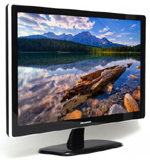
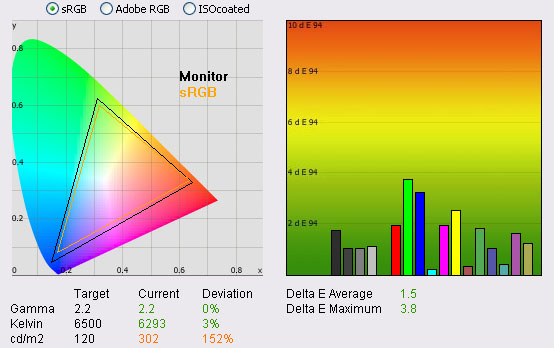
|
|
Default Settings |
|
Luminance (cd/m2) |
302 |
|
Black Point (cd/m2) |
0.32 |
|
Contrast Ratio |
943:1 |
The HZ27WC unit which was sent to us for testing
has had the factory calibration applied and so these are hopefully a more
representative view of what you can expect from these screens out of the box. I
have taken these default measurements with the brightness control set at
maximum. I am unsure which setting will be used out of the box so this could
vary and there's no OSD menu to do a "factory restore". The default luminance
could vary as a result so I will disregard this measurement here. The default
gamma of the screen was spot on at 2.2 and colour temperature was 6293k, being
only 3% out from the target which was also very good. The contrast ratio
recorded was a very respectable 943:1 which is excellent for an IPS panel. This
is of couse much better than the HZ27WA test above where the unit had not been
factory calibrated and the digital white/black balance was off. Even colour
accuracy was very good here with dE average of only 1.5 and maximum of 3.8. It's
very easy to change the brightness control to return a comfortable luminace and
so this performance should be adequate for most users easily. A very good out of
the box performance here. You may not even need further calibration for every
day use unless you need higher end accuracy or want to use it for colour
critical work.

Calibrated Results
I wanted to see what was possible from both
screens with some accurate profiling and calibration. First though I wanted to
overcome the poor default contrast ratio from the HZ27WA sample we had. To do this you must alter the
controls for digital white and black level using the brightness and contrast
controls in the OSD respectively. I ran a series of tests to determine the
optimum combination to return the best contrast ratio, without impacting the
screen in an overly negative way. I first plotted the contrast ratio at each
combination as shown below:
|
|
Brightness |
|
 |
|
0 |
10 |
20 |
30 |
40 |
50 |
|
0 |
93 |
120 |
149 |
181 |
191 |
101 |
|
10 |
142 |
166 |
209 |
245 |
236 |
124 |
|
20 |
181 |
218 |
269 |
310 |
292 |
146 |
|
30 |
222 |
267 |
315 |
380 |
354 |
175 |
|
40 |
282 |
334 |
369 |
441 |
407 |
209 |
|
50 |
348 |
407 |
443 |
527 |
484 |
247 |
|
60 |
421 |
488 |
527 |
582 |
567 |
288 |
|
70 |
610 |
674 |
743 |
798 |
661 |
347 |
|
80 |
748 |
801 |
866 |
941 |
737 |
352 |
|
90 |
827 |
898 |
947 |
942 |
786 |
386 |
|
100 |
952 |
943 |
948 |
942 |
844 |
386 |
From these tests I was able to establish the
optimum settings for the digital white and black levels. The highest contrast
ratios were returned when the contrast control was set at 90 - 100. When at these
settings, brightness had to be below 20 otherwise there was some obvious
gamma shift and the whole image became very washed out. I tested each of the
maximum contrast ratio combinations in turn to determine how the screen was
set up in terms of colour temperature and gamma. I found that the best
combination was 10% brightness and 100% contrast settting, which returned us
not only a high contrast ratio, but a
good gamma of 2.2 average (1% out) and a good colour temperature of 6563k (1%
out) as well. At the other high contrast ratio combinations the gamma was quite a long way
off from the target of 2.2 so this did seem to be the optimum starting point
for a calibration. It had even improved the gamma and white point compared
with our out-of-the-box settings, which had returned gamma of 2.0 (9% out) and
7408k (14% out) respectively. The only negative really with this change was
that the colour accuracy was not as good as default settings, with dE average
of 5.2 and a maximum of 12.7 now. We will of course be correcting that through
further calibration steps. I would recommend reverting to these OSD settings
for brightness and contrast to get the right white/black balance and return
you the best contrast ratio available, and also a decent gamma and white point
set up. You will need to turn the backlight intensity down a little using the
ECO mode as a luminance of 188 cd/m2 is produced at the default 50%
ECO setting.
Hazro have informed me that the sample we were
sent was delivered without their factory calibration, and that the retail
stock will be factory calibrated correctly to address this issue, and also to
bring the performance in line with the targets of
2.2 gamma, 6500k white point and 120
cd/m2
brightness. This is positive news, but even if this wasn't done it is simple
enough to correct the contrast ratio through this basic adjustment to the OSD
controls. The HZ27WC sample we had did come factory calibrated which was good
since there is no OSD, and no control over the digital white and black levels
anyway.

Hazro HZ27WA
- Calibrated Settings
|
Monitor OSD Option |
Adjusted Setting |
|
Brightness |
10 |
|
Contrast |
100 |
|
Color Temp |
User |
|
RGB |
30, 17, 25 |
|
ECO Mode |
25 |

|
|
Calibrated Settings |
|
luminance (cd/m2) |
119 |
|
Black Point (cd/m2) |
0.16 |
|
Contrast Ratio |
747:1 |
As I discussed in the previous paragraph I had
found the optimum settings for brightness and contrast (digital white and black
levels) to be 10 and 100% respectively. This had returned the best contrast
ratio at default settings while also giving an accurate gamma and white point
starting point. I also switched here into the 'User' preset mode which allowed
me access to the individual controls for red, green and blue (RGB). These were
changed to the values shown as part of the calibration process as guided by the
LaCie software. The ECO mode was also turned down to 25% here which helped
reduce the luminance to around 120
cd/m2. The
rest of the corrections would be carried out by the software at a graphics card
LUT level, and through the creation of the ICC profile. There is no hardware
level calibration available from this screen as you will find on some high end
professional screens.
The calibration was a great success. Gamma, colour
temperature and luminance were all pretty much spot on. There was a more
comfortable luminance of 119
cd/m2 now, and we had a black depth of 0.16 cd/m2 which
was actually pretty good and a vast improvement over the default settings. This was
pleasing and gave us a reasonably high static contrast ratio of 747:1. This was not as
good as the pre-calibrated settings where we had changed the brightness/contrast
controls only and seen up to around 943:1. However, this was a calibrated
result with correction of grey scale tracking, white point, gamma and colour
tones. Colour accuracy was now much better with an average dE of only 0.3. LaCie
would consider colour fidelity to be excellent from this test. Maximum dE was
only 0.7, so a significant improvement compared with the factory settings. This
screen is a standard gamut model and so for those wanting to work in the sRGB
colour space and not have to contend with some of the issues of wide gamut
screens, it is an obvious choice in the 27" market. Of course if you were
wanting to work in a wider colour space such as Adobe RGB this screen cannot
offer that.
Testing the screen with colour gradients showed pretty smooth transitions with some very slight stepping in darker tones. There was no banding
evident. Since this
pre-production sample unit did not feature the factory calibration I would not
recommend using our settings or ICC profile on your HZ27WA model since the
starting point is drastically different. The above tests should still give you
an indication of what the screen is capable of however.

Hazro HZ27WC
- Calibrated Settings
|
Monitor Control |
Adjusted Setting |
|
Brightness |
Setting 2 |
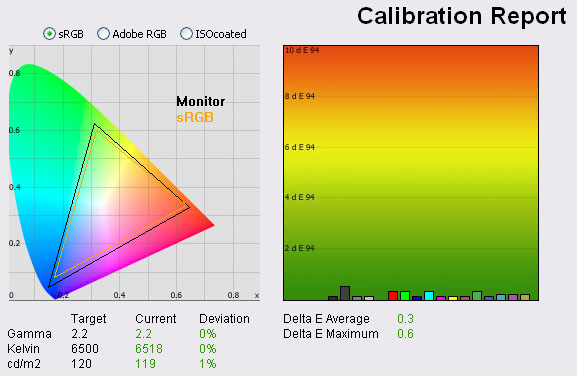
|
|
Calibrated Settings |
|
luminance (cd/m2) |
119 |
|
Black Point (cd/m2) |
0.16 |
|
Contrast Ratio |
744:1 |
Although the default settings of the HZ27WC were
very pleasing, I carried out the usual calibration process again. There is no
OSD menu and so there are no hardware changes to be made other than altering the
backlight brightness control to an optimum starting point. You cannot control
the RGB channels or contrast and so all other corrections would be made at a
graphics card LUT level and through the creation of the ICC profile by our
spectrophotometer.
The calibration didn't actually need to correct
much in terms of gamma which was already spot on out of the box at 2.2 average.
It did correct the slight offset of the white point, bringing it within 0.5% of
the taraget at 6518k. At the selected backlight setting of 2 (see our
contrast stability
section for explanation) we had a comfortable luminance of 119
cd/m2 now. Out of the box we found that the brightness setting of 1
actually returned a luminance of around 121
cd/m2 but you may notice we have used a setting of 2 here which
returned us a default measurement of 160
cd/m2. This is because once the grey scale corrections and other
alterations have been made, the brightness setting of 1 resulted in a luminance
of around 110
cd/m2 which was too low. The setting 2 returned us a luminance of 119
cd/m2 as shown above after all other graphics card corrections are
taken into account. With a black depth of 0.16
cd/m2 we had a moderate static contrast ratio of 744:1 which was
pretty much identical to the HZ27WA results above. Colour accuracy was also corrected
nicely to 0.3 dE average / 0.6 maximum.
Testing the screen with colour gradients showed pretty smooth transitions with some very slight stepping in darker tones. There was no banding
evident. You can use our settings and try our
calibrated ICC profile if you wish, which is available in
our ICC profile database.

Calibration
Performance Comparisons
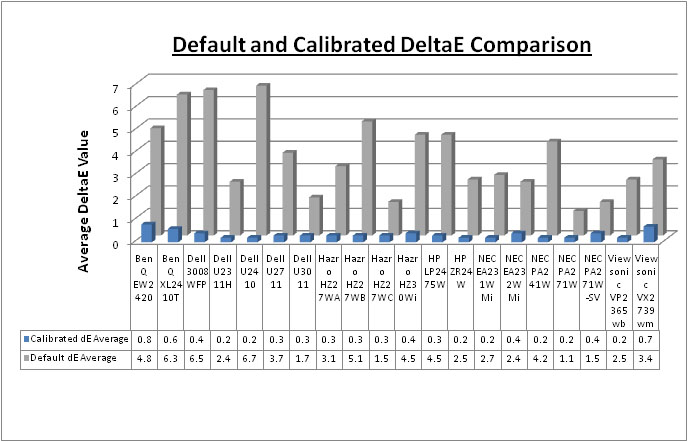
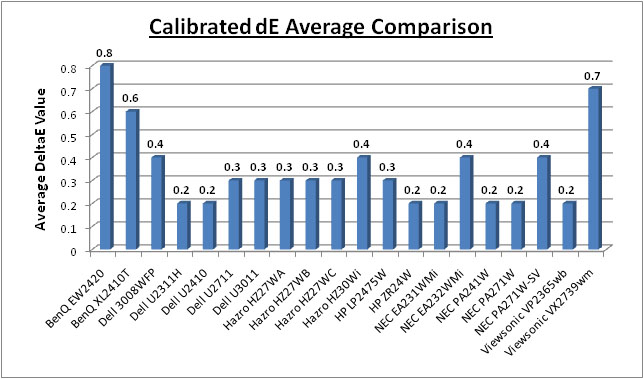
I have plotted the performance of the HZ27WA and
HZ27WC above
compared with some of the other models we have tested in a similar size range.
Default colour accuracy out of the box was moderate from the HZ27WA, with an average dE of 3.1 recorded.
Keep in mind that this sample unit did not have the factory calibration applied.
Despite this, it was
pretty comparable to the Dell U2711 (3.7) and a little better than the 27" CCFL
Hazro model, the HZ27WB (5.1). This un-calibrated default colour accuracy was pretty good from
the HZ27WA but it was unfortunately not great out of the box in other areas,
most notably in black depth and contrast ratio. Without the factory calibration
you would certainly want to
correct the black depth/contrast as we described earlier, but this does affect
default colour accuracy. The change to 100 contrast / 10 brightness setting
altered the average dE to 5.2 which was more in line with the default colour
accuracy we had seen from the HZ27WB. We would hope that the factory calibration
of the HZ27WA brings it much more in line with the HZ27WC tests. We found
default settings to be very good there, with spot on gamma, very good white
point, high static contrast ratio and even a good colour accuracy with dE
average of only 1.5. A great result from the factory calibration there so I
would hope you can expect the same from both models from retail stock.
Once calibrated, most of the models
were very similar in this test. The HZ27WA and HZ27WC were both recorded as average dE of 0.3 which was
the same as the HZ27WB and very close to the 30" HZ30Wi (0.4), old 26" HZ26Wi (0.5) and
old 30" HZ30W (0.3). Some of the professional range models from NEC are even more
accurate. Professional grade monitors like the NEC PA series also offer other
high end features which separate them from some of these other models, including
extended internal processing, 3D LUT's and hardware calibration. These
comparisons are based on a small selection of tests, so it should be remembered
that other factors do come into play when you start talking about professional
use. For further information and tests of a high end professional grade screen
with hardware LUT calibration, you may want to have a read of our
NEC SpectraView Reference 271 review.
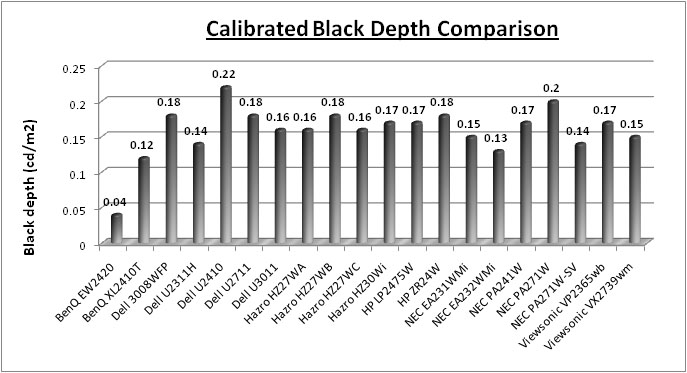
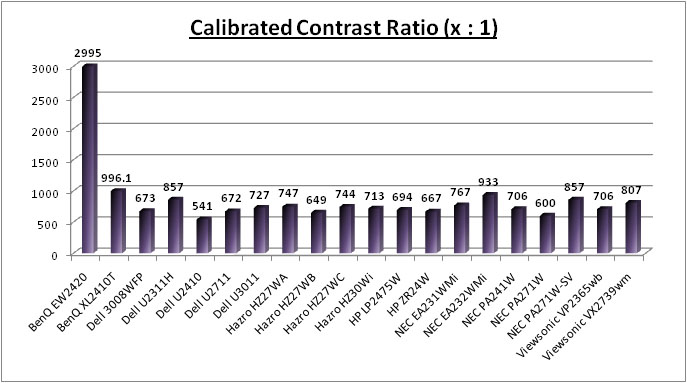
Once we had altered the OSD brightness and
contrast control, the calibrated black depth of the HZ27WA was
actually good for an IPS matrix. At 0.16 it was better than the Dell U2711
(0.18) and Hazro HZ27WB (0.18) which was good, and on par with the Hazro HZ30Wi (0.17).
The factory calibrated HZ27WC already had the digital white/black balance
corrected and also returned a calibrated black depth of 0.16. Hazro have made
some significant improvements in black depth compared with their older models as
well,
where the HZ26Wi could only achieve 0.58 and the HZ24W 0.38. The modern IPS
panels being used in their new range of screens have come on a lot in this
regard, not to mention the fact that Hazro have also added a backlight control
which was missing altogether from the HZ26Wi for instance. The range of the backlight
control of the HZ27WA isn't quite as good as the HZ27WB but it is still there thankfully. The recently tested
BenQ EW2420
was a long way ahead from all the other models here of course, with its new
W-LED backlit AMVA panel offering a reading of 0.04. Contrast ratio of the
HZ27WA was 747:1, and the HZ27WC was 744:1, which was ahead of the Dell U2711 (672:1) and Hazro HZ27WB
(649:1). Again pretty good for an IPS panel and certainly a lot better than the
older models.

Contrast
Stability
I wanted to see how much variance there was in the screens contrast as we
adjusted the monitor setting for brightness.
In theory, brightness and contrast are two independent parameters, and good
contrast is a requirement regardless of the brightness adjustment.
Unfortunately, such is not always the case in practice.
As we
have already discussed, the OSD brightness control would normally represent a
control over the intensity of the backlight on a modern display. However, on
the HZ27WA it controls the digital white level and so has a severe impact on
the contrast ratio. We have already compared the contrast ratio results across
a range of adjustments in our
calibration section.
For this test, we used the 'ECO mode' control to adjust the backlight
intensity instead.
We recorded the screens luminance and black depth at the five settings
available, and calculated the contrast ratio from there. It should be noted
that we used the BasICColor calibration software here to record these, and so
luminance at default settings varies a little from the LaCie Blue Eye Pro
report.
I used our optimum settings
for contrast and brightness in this test (10 / 100), as opposed to the default
50/50 as we have already identified this returns the optimum contrast ratio
and gamma / white point set up.
|
OSD ECO Mode |
Luminance
(cd/m2) |
Black Point (cd/m2) |
Contrast Ratio
( x:1) |
|
100 |
343 |
0.37 |
928 |
|
75 |
284 |
0.30 |
945 |
|
50 |
189 |
0.20 |
947 |
|
25 |
139 |
0.15 |
988 |
|
0 |
100 |
0.11 |
911 |
|
Luminance Adjustment Range = 243 cd/m2
Black
Point Adjustment Range = 0.26
cd/m2
Average
Contrast Ratio = 943:1
|
Although there was only a limited number of
settings for the ECO mode, 5 to be precise, the control did allow a pretty
decent adjustment range of the luminance of the screen. At 100%, the luminance
was 343
cd/m2 which
was a little lower than the specified maximum brightness of 420 cd/m2.
Remember this is using optimum white/black level adjustments so perhaps you can
achieve a higher luminance at the cost of contrast ratio but I wouldn't
advise it. At the lowest 0% setting the luminance was a reasonably low 100 cd/m2.
You would probably want to use either the 0% or 25% setting to return a
luminance close to the recommended 120 cd/m2 for LCD screens in
normal lighting conditions. The black depth ranged from 0.37 cd/m2
down to 0.11 cd/m2 which was good. We had a stable contrast ratio
across this range of adjustments as you would hope, with an average of 943:1. It
would have perhaps been nice to see more steps available from this ECO mode
setting. The HZ27WB had 20 different levels of backlight control, but there are
only 5 here. At least it is included though! We plotted the stability of the
contrast ratio on the graph below:
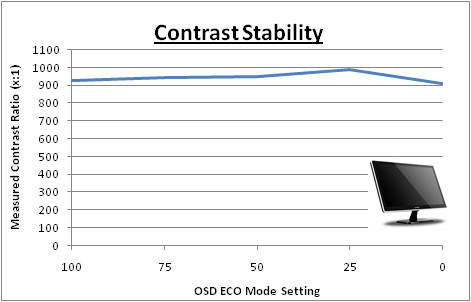
Above: contrast
stability of the HZ27WA
HZ27WC Tests
I ran the same tests on the
HZ27WC. This model does not have an OSD and so there is no control over the
digital white or black levels. We only have control over the backlight
intensity so will have to rely on a good factory calibration here when it
comes to contrast ratio.
|
Backlight
Control |
Luminance
(cd/m2) |
Black Point (cd/m2) |
Contrast Ratio
( x:1) |
|
10 |
306 |
0.31 |
986 |
|
9 |
300 |
0.31 |
969 |
|
8 |
295 |
0.30 |
983 |
|
7 |
285 |
0.29 |
984 |
|
6 |
270 |
0.28 |
965 |
|
5 |
249 |
0.26 |
958 |
|
4 |
223 |
0.23 |
970 |
|
3 |
192 |
0.20 |
962 |
|
2 |
160 |
0.16 |
998 |
|
1 |
121 |
0.13 |
929 |
|
0 |
78 |
0.08 |
970 |
|
Luminance Adjustment Range = 228 cd/m2
Black
Point Adjustment Range = 0.23
cd/m2
Average
Contrast Ratio = 970:1
|
Thankfully the screens digital white and black
balance has been set correctly from the factory and so we have a decent contrast
ratio produced. Firstly I wanted to talk about the control over the backlight
offered by the HZ27WC. There is no OSD and so it's difficult to tell which
setting you are in unless you have a colorimeter or some way of actually
recording the luminance change in the screen. When you press the up/down button
you can obviously feel the 'click' and the power LED blinks once. However, it
does seem that this is a little tempramental and not every press actually
results in a change in the backlight. Overall through our measurements above we
recorded 11 distinct settings for this control which allowed you to control the
luminance between 306 and 78
cd/m2. I'll
refer to them in this way elsewhere in the review, with setting 10 being the
maximum setting, adn setting 0 being the lowest. The changes at the top end of
the scale made smaller differences to the luminance of the screen, and a less
noticeable change was made in the brightness that you observe. As you reached
further down the scale of adjustments, the changes were more pronounced and
obvious to the naked eye, and the difference between each step was larger.
Thankfully this backlight control did offer a wide range of adjustments to the
luminance of the screen, and there were more settings available in fact than the
5 from the HZ27WA using the ECO mode control. Contrast ratio remained static
across the range very well with an average of 970:1. I have plotted the results
of the HZ27WC below:
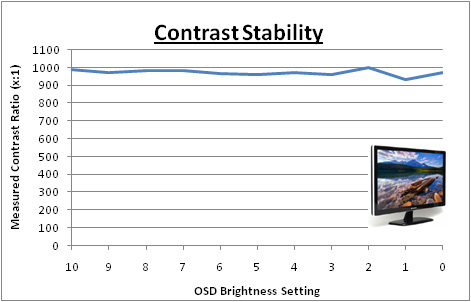
Above: contrast
stability of the HZ27WC

Dynamic Contrast
(HZ27WA)
|
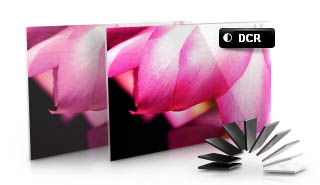 |
The Hazro HZ27WA features a dynamic contrast
ratio (DCR) control, which boasts a spec of 1 million:1. This is not available
from the HZ27WC.
Dynamic contrast ratio involves controlling the
backlight of the screen automatically, depending on the content shown on the
screen. In bright images, the backlight is increased, and in darker images, it
is decreased. For this test I would use the colorimeter to record the
luminance and black depths at the two extremes. Max brightness would be
recorded on an all white screen once the DCR has caught up. Black depth would
be recorded on an all black screen. |
The DCR feature is available through the 'Misc'
sub-menu and it has a simple on or off setting. You can use it no matter which
colour preset mode you are in.
So where does this 1 million:1 figure come
from? - As opposed to gas-discharge lamps (CCFL), LED's can be lit up instantly
or turned out completely. This can lead to extremely high levels of dynamic
contrast. Figures in the millions are very common now. But in real
applications, for example when watching a movie, there are no absolutely black
frames even in the credits. Most of the time there is something on the screen
besides blackness and a monitor with a huge specified dynamic contrast will
never have the chance to deliver it in practice. As a result, there is no real
practical point in increasing the dynamic contrast higher than about 10,000:1
which has already become standard for many monitors, including those with a
backlight based on CCFL lamps. Keep in mind that DCR figures are often
exaggerated as a result, and since you will probably never get to utilise the
full figure in practice, don't be fooled into buying into the hype too much!
|
|
User preset mode |
|
Max luminance (cd/m2) |
252 |
|
Min Black Point (cd/m2) |
0.20 |
|
Max Dynamic Contrast Ratio |
1262:1 |
The dynamic contrast ratio control didn't do a
massive amount but then this is common from many displays with this technology.
The DCR did operate smoothly and offered quick transitions. However, the range
of operation was not massive. In the brightest examples the luminance ranged up
to 252
cd/m2, and in
the darkest examples it reached down to only 0.20 cd/m2. This gave us a
dynamic contrast ratio of 1262:1 which did at least work a little, and improved
our static contrast ratio of 747:1.
To be honest this 1 million:1 figure is
exaggerated
massively anyway. Even if the DCR technology could control the full range of the
backlight properly, you would only have a maximum luminance of around 343
cd/m2, and a
minimum black point of 0.11 cd/m2. You can see this from our
contrast stability
tests above. This would only give you a maximum DCR of 3118:1 anyway so a
long way off the advertised figure. In practice it managed about 40% of this
potential maximum. If we took Hazro's maximum brightness spec of 420 cd/m2, you would need a black point of 0.00042 cd/m2
(basically completely black) to
achieve the 1 million:1 figure, something which clearly this panel is
not capable of, even at 0% intensity. This figure would only be produced if the
LED backlighting was being completely turned off, something which is possible
through local dimming technology but not something which is widely used yet and
not available from this screen. Overall it doesn't live up to its advertised
spec, but that's normal with dynamic contrast ratios anyway. At least it does
something and offers some extension to the static contrast ratio.

Viewing Angles

Above: Viewing angles shown from front and side, and from above and below.
Click for larger version
Viewing angles of the HZ27WA and HZ27WC were very good as you
would probably expect from an IPS based panel. Horizontally there was very
little colour tone shift until fairly wide angles past about 45°. Contrast
shifts were also minimal thankfully, and only really noticeable after about 45°.
Vertically the contrast shifts were a little more obvious and noticeable with
smaller movements away from a central point of view. The screen did offer the wide viewing angles of IPS
technology and was free from the very restrictive fields of view of TN Film
panels, especially in the vertical plane. It was also free of the off-centre
contrast shift you see from VA panels. On black images you could detect a white
tint from a wide angle, characteristic of H-IPS matrices.

Panel Uniformity
Measurements of the screens luminance were taken
at 35 points across the panel on a pure white background. The measurements were
taken using BasICColor's calibration software package, combined with the LaCie
Blue Eye Pro colorimeter. The above uniformity diagram shows the difference, as
a percentage, between the luminance recorded at each point on the screen, as
compared with the reference point of a calibrated 120 cd/m2. This is
the desired level of luminance for an LCD screen in normal lighting conditions,
and the below shows the variance in the luminance across the screen
compared with this point. It is worth noting that panel uniformity can vary from
one screen to another, and can depend on manufacturing lines, screen transport
and other local factors. This is only a guide of the uniformity of the sample
screen we have for review.
HZ27WA Tests
Uniformity of Luminance (HZ27WA)
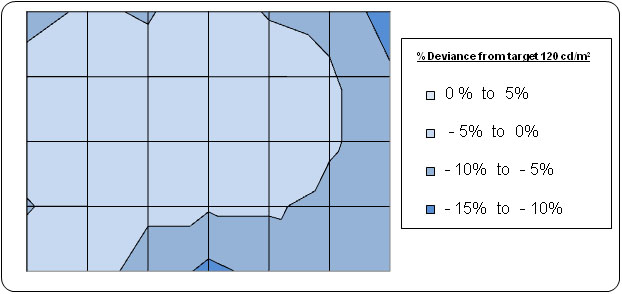
The uniformity of the HZ27WA was excellent.
97% of the screen was recorded as having a luminance within 10% deviance of
the target 120
cd/m2 which was excellent. The
luminance fluctuated down to about 107 cd/m2 in the upper right
hand quadrant, and down to around 108 cd/m2 along the lower edge.
This was an excellent result from any display, and this is all without the
need for additional uniformity correction technologies.
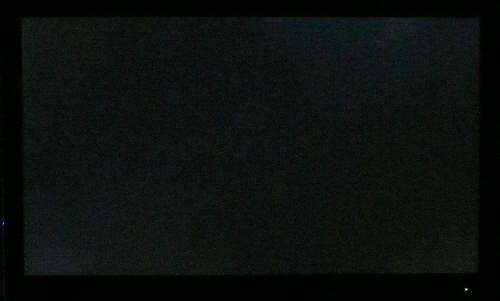
Above: All black screen in a darkened room. Click for larger version
(HZ27WA)
As usual we also tested the screen with an all
black image and in a darkened room. A camera was used to capture the result.
There was very little backlight leakage noticeable to the naked eye in this
test. There was some very slight variation in the bottom left and top right hand
corners which was picked out by the camera, but it was very minimal. No real
issues at all here with this test which was pleasing.
HZ27WC Tests
Uniformity of Luminance (HZ27WC)
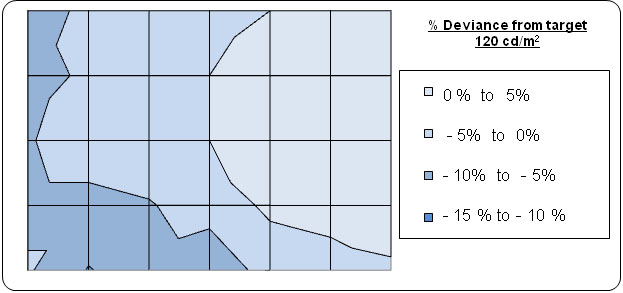
Luminance uniformity of the HZ27WC was very
good as well with only minimal variations across the panel. The left hand
side was ever so slightly darker in this test by about 6 - 10%, but not
something you could detect in practice. Like the HZ27WA, 97% of the screen
was recorded as having a luminance within 10% deviance of the target 120
cd/m2 which was excellent. The
luminance fluctuated down to about 107 cd/m2 in the lower left
hand quadrant.
This was again an excellent result from any display, and this is all without the
need for additional uniformity correction technologies.
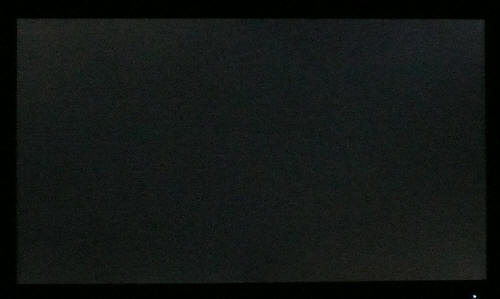
Above: All
black screen in a darkened room. Click for larger version (HZ27WC)
Again I tested for backlight leakage. There was some very slight variation in
the four corners here which the camera just about picked out, but it was very minimal. No real
issues at all here with this test which was pleasing. Both screens have been
very good in this regard which is pleasing.

General and Office Applications
The HZ27WA/C features a massive 2560 x 1440 WQHD
resolution which is only just a little bit less vertically than a 30" screen.
The pixel pitch of 0.233mm is very small as a result, and by comparison a
standard 16:10 format 24" model has a pixel pitch of 0.270mm and a 30" model has
0.250mm. These ultra-high res 27" models offer the tightest pixel pitch and
therefore the smallest text as well. I don't find it too small personally, but
day to day I am used to a 24" screen. Some users may find the small text a
little too small to read comfortably, and I'd advise caution if you are coming
from a 19" or 22" screen for instance where the pixel pitch and text are much
larger. I found a 30" screen to be quite a change with text size when I first
used one, and this is very similar and even a little bit smaller! I still
personally prefer the slightly larger text of a 24" model myself, but I expect I
could happily get used to the added resolution on these models given time.
The massive resolution is really good for office
and general use, giving you a really big screen area to work with. It is a
noticeable upgrade from a 24" 1920 x 1200 resolution, and it's good to see Hazro
have opted for the high res panel here rather than sticking with another 1920 x
1200 res panel as you may find in other older 27" models. For those wanting a
high resolution for CAD, design, photo work etc, this is a really good option.
The image was very sharp and crisp and text was very clear.
There were no preset modes available from either
screen as they are a 'no-frills' option designed to bring you good performance but
at a very low cost. On the HZ27WA there is at least a reasonable OSD menu, so you can make a
few adjustments. There is a fairly limited set of adjustments
available from the backlight control (ECO mode) but they offer a good range of luminance for the screen which is good.
The same can be said for the HZ27WC which offers a good range of adjustments
over the backlight if nothing else. You should be able to
easily obtain a comfortable setting for office use, depending on your ambient
lighting conditions, probably wanting to use either the 0% or 25% ECO mode
setting on the HZ27WA and a setting of either 1 or 2 (in our scale) on the
HZ27WC. Since there are no presets or different modes, you will
have to change this control if you want to have a different setting for movies
or games.
The 30" HZ30Wi did offer 4x USB ports which are
always useful for connecting external devices such as printers and cameras.
These have been left off the HZ27WA/C (and HZ27WB) models unfortunately, again to
keep costs low. Compared with some competing models like the Dell U2711 for
instance, the HZ27WA/C is certainly lacking in these areas. Dell have provided
every connection and extra you could probably want, but the cost of their model
is obviously higher as a result. The tilt function allows for a reasonable range
of adjustments to get a comfortable viewing angle. Unfortunately there is no
height adjustment which might be missed by some people. There is no rotate
function either to switch between portrait and landscape modes, but the
practicalities of using that on a screen this size are questionable. The
integrated speakers should be more than adequate for general office sounds and
light music as well.

Responsiveness and Gaming
The Hazro HZ27WA/C was tested using the chase
test in PixPerAn, a good bit of software for trying to quantify differences in
real terms responsiveness between monitors. As a reminder, a series of pictures
are taken on the highest shutter speed and compared. The images below show the
best case example on the left hand side, and the worst case example on the right
hand side. This should only be used as a rough guide to comparative
responsiveness but is handy as a way of keeping a constant test of each screen.

27"
6ms G2G LG.Display H-IPS (W-LED)

27"
6ms G2G LG.Display H-IPS (W-LED)

27"
6ms G2G LG.Display H-IPS (WG-CCFL)

30" 8ms
G2G LG.Display H-IPS (WG-CCFL)
The Hazro HZ27WA and HZ27WC both use an H-IPS panel
from LG.Display (LM270WQ1). The panel itself is rated by LG.Display as having a
14ms ISO response time on paper, but with an overdrive impulse applied, Hazro
have rated the screen with a 6ms grey to grey (G2G) response time figure. This
screen makes use of
response time compensation (RTC) technology, to boost the pixel transitions
across the range. This technology can significantly help reduce motion blur and
ghosting compared with non-RTC panels in practice.
These tests revealed a good result from both
screens. I have first provided a comparison against the HZ27WB and HZ30Wi models
here. The screen actually showed less motion blur in practice than the HZ27WB
which is also rated with a 6ms G2G response time. The moving car was
sharper in appearance and there was a less pronounced blur to the movement. You
can see this from the pictures above which show a more obvious trail behind the
car in the best case photos of the HZ27WB. The HZ30Wi was a little better than
the HZ27WB in this regard, but again the blur was slightly less noticeable on
the HZ27WA/C which was positive.
The HZ27WA and HZ27WC did actually vary a little
bit from one another and I was able to run this test side by side for a
comparison. On the HZ27WC there was an ever so slightly more pronounced blur
from the image as you can see from the pictures above. It was still better than
the HZ27WB and quite similar to the HZ30Wi in fact. This was actually reduced a
little on the HZ27WA model, however there was some slight overshoot of the RTC
impulse evident in the form of a dark trail behind the speech bubble and head,
and a slight pale halo behind the car. Overshoot of an RTC impulse can be quite
common on modern screens using this technology, and its severity depends on the
control of that impulse. Some models show a far worse overshoot than is evident
here, and although you can pick it out, it is not too bad at all. The HZ27WC
appeared to be free of this overshoot artefact perhaps down to the differing
internal electronics. This could be due to the use of two scalers on the HZ27WA
and the fact that the HZ27WC does not have any. Perhaps these are having a
slight impact on the RTC impulse control. It's being applied a little more
aggressively on the HZ27WA but at the cost of some slight overshoot. I'd
personally say that these two models are very similar in terms of responsiveness
in practical use.

27"
6ms G2G LG.Display H-IPS (W-LED)

27"
6ms G2G LG.Display H-IPS (W-LED)

27" 6ms
G2G LG.Display H-IPS

27" 1ms G2G CMO TN
Film (Response time mode = Advanced)

24" 6ms
G2G LG.Display H-IPS
I have also provided a comparison of the screens
against some of the other 27" models we have tested, and the very popular
Dell U2410. The HZ27WA performs very similarly to the
Dell U2711 here in fact which shows a low level of blur, but some RTC
overshoot as well. It's on par with the Dell in these tests. The
ViewSonic VX2739wm is a gamer-orientated screen with an advertised 1ms G2G
response time from its fast TN Film panel. It shows a faster response time
compared with the IPS based 27" models here, and is free (in the Advanced mode)
of any noticeable overshoot or dark trailing. The Dell U2410 is a little more
responsive than the U2711 and HZ27WA and again doesn't show any obvious
overshoot.

27"
6ms G2G LG.Display H-IPS (W-LED)

27"
6ms G2G LG.Display H-IPS (W-LED)

23.6" 2ms G2G CMO TN Film + 120Hz

22" 3ms
G2G Samsung TN Film + 120Hz
I've also included a comparison above against two
gamer-orientated screens, both featuring heavily overdriven TN Film panels, and
120Hz technology. The pixel responsiveness of both of these is a little ahead of
the HZ27WA/C as you will probably expect and the 120Hz frequency allows for
improved 120fps frame rates and the support of 3D content as well. The BenQ
XL2410T does show some rather noticeable RTC overshoot in the form of dark
trails behind the moving image (speech bubble and head) which is unfortunate,
and a sign that the RTC impulse is too aggressive. This is more apparent than on
the HZ27WA which shows these artefacts to a lesser degree. The Samsung 2233RZ
remains our champion in this test.
The Hazro HZ27WA/C should be perfectly adequate for
most gaming but those wanting to play fast FPS may still want to look elsewhere,
perhaps at some of the modern 120Hz TN Film models with super fast response
times and support for 120fps frame rates and 3D content.
-
Aspect Ratio Control - Unlike the CCFL
based HZ27WB, the HZ27WA offers options for hardware level
aspect ratio control, with settings for normal, 16:9, 4:3 and 1:1 pixel
mapping. This is a decent range of options available thanks to the scaler used.
Since the HZ27WC DVI-only version does not feature a scaler, these options are
not available on that model and you would have to rely on your graphics
card for any aspect ratio retention.

Input Lag
As usual I tested the
screen in clone mode with a CRT to determine the level of
input lag. This is
something which can put off some gamers and is a delay between graphics card and
monitor output. By hooking up a CRT you can show that the LCD lags behind
somewhat, which can affect users in some situations where they rely on the
screen image being as fast as their inputs (e.g. fast FPS shooting games).
Often, input lag is very low and probably wouldn't represent too much of a
problem in real terms.
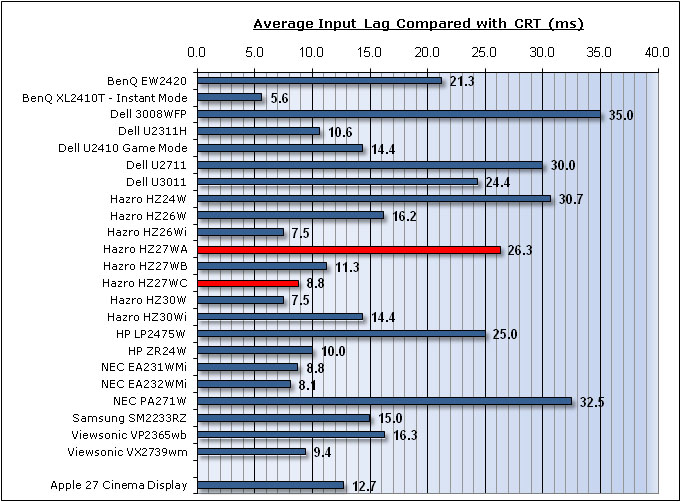
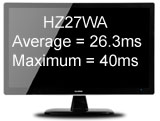
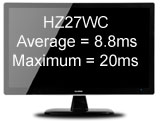

The input lag of the HZ27WA was moderate here with
an average lag of 26.3ms recorded, ranging up to 40ms in the worst cases. It was
not quite as fast as the HZ27WB (11.3ms) or HZ30Wi (14.4ms) which had no
in-built scaler. Because the HZ27WA has two scalers, the input lag is a little
higher. However, because these scalers enable features like the added Frame Rate
Control for "10-bit colour" support, and options for aspect ratio control,
this small sacrifice is arguably worth it. Even at 26.3ms average, it is not
that much and should be fine for casual gaming. It is also very similar to the
Dell U2711 which was recorded at 30ms average.
Without scalers the HZ27WC is faster in this test
with an average lag of only 8.8ms, far more in keeping with the other Hazro
models without a scaler and a very good result. This makes it a better choice
for competitive gaming. I have provided the result of the Apple 27" Cinema
Display, as recorded in a review by Anandtech which was 12.7ms. Again there are
no scalers available on the Apple screen and not even an OSD menu, which
explains the reduction there compared with the HZ27WA; but the HZ27WC was a
little faster.

Movies and Video

The following summarises the Hazro HZ27WA/C's performance
in video applications:
-
27" screen size make this a fairly good cross-over
between desktop monitor and LCD TV
-
16:9
aspect ratio format suitable for movies and films and provides fewer black
borders than a 16:10 format screen
-
2560
x 1440 resolution is more than enough to handle a full 1080 HD resolution
(1920 x 1080)
-
Digital interface supports HDCP for any encrypted and protected content
-
Additional interfaces available from the HZ27WA, with options for
1x DVI, 2x VGA, 1x HDMI and 1x component. Good to see HDMI included here. The
screen is missing DisplayPort which is increasingly popular but there are
certainly more options here than on the HZ27WB (DVI only) and Apple Cinema
Display (mini DisplayPort only). The HZ27WC is not as versatile with only a DVI
interface available
-
Aspect ratio control available from the HZ27WA for
external devices. Not available on the HZ27WC.
-
Viewing angles are wide from the IPS panel. You
can easily watch video content from different angles. This should also be fine
for multiple viewers at once.
-
Black depth and contrast ratio are pretty good
for an IPS panel once the balance has been set between digital white and black
level. Detail in darker scenes should not be lost
-
Dynamic contrast ratio is available on the HZ27WA
model and works to a
small degree, increasing contrast ratio from about 747:1 static to 1262:1
dynamic. Some
people like this technology for multimedia content. It is not available at all
from the HZ27WC.
-
No 'multimedia' or 'movie' preset modes available
meaning you need to use the same mode for office work as for movie work.
Sometimes these presets can be handy for boosting brightness and colours to make
movies more attractive.
-
Good pixel responsiveness which should mean the screen is capable of handling fast moving
images.
-
Excellent panel uniformity and no obvious backlight
leakage from either variant. This can sometimes be an issue in movies especially along edges where
black borders are present but not on this screen.
-
Limited ergonomic range available from the basic tilt adjustment.
Since there is no height or swivel, this
could become a factor if you want to watch movies from a different position
other than your normal sitting-at-the-desk spot.
-
Integrated 2x 5W stereo speakers might be useful for 'light' sound and general
use
-
Glossy panel coating may present problems with reflections depending on your
viewing position and lighting conditions. Keep it away from a window as they
are particularly noticeable.
Since the HZ27WA offers the additional interfaces,
aspect ratio control
and support for dynamic contrast ratio, it is more suitable for movies and
multimedia than the HZ27WC.

Differences Between the HZ27WA and HZ27WC

From a technical point of view here is a quick
summary of the differences between the HZ27WA and HZ27WC:
-
HZ27WA - DL-DVI, 1x HDMI, 2x VGA and
component interfaces available. Provided with cables for 1x DL-DVI, 1x VGA,
1x HDMI, 1x stereo audio and power supply (no component). OSD available. 2 in-built
scalers offering hardware level aspect ratio control. These also allow for
additional controller board level frame rate control for 10-bit sources and
support of higher colour depth where available. Dynamic contrast ratio
available. 5 defined adjustments possible to backlight intensity. Slightly higher retail cost.
-
HZ27WC - DL-DVI interface only. Comes
packaged with DVI and stereo cables only. No OSD menu available, only quick
access control over power, backlight and volume. 11 defined steps for backlight
intensity control. There are no scalers available
on this model so the support for 10-bit sources and aspect ratio control are not
available. Lower retail price as a result of these cut-backs.
In terms
of performance the screens are quite similar. I can't fairly analyse their
default factory settings as the HZ27WA unit was not factory calibrated when it
was sent to me. If the HZ27WC's very good out of the box performance is anything
to go by then this is very promising. A good default setting and the contrast
ratio issue had been fixed. Responsiveness was slightly different on the HZ27WC
with an ever so slightly more noticeable blur, but freedom from the RTC
overshoot we saw on the HZ27WA. The input lag was considerably lower which is
great for those wanting to use this screen for fast gaming. The HZ27WC is more
suited for gamers as a result. The HZ27WA holds the edge for multimedia and
movies thanks to its additional interfaces, aspect ratio control and dynamic
contrast ratio. In other areas the performance was very comparable and
impressive.

Conclusion
As I had been with the HZ30Wi and HZ27WB, I was
suitably impressed by the performance of the HZ27WA and HZ27WC. Despite it being a
no-frills offering it does offer a decent range of options, some nice extras and
some great performance. Comparisons with the Apple 27" Cinema Display are bound
to be made here. Aesthetically the screen is very similar to Apple's display,
and this screen is really the only alternative with similar features and specs.
The use of an IPS panel is bound to attract the usual high level of interest,
and this is the only other standard gamut IPS offering in the 27" sector. Those
wanting to work in a standard sRGB colour space will find this a great option
and a compelling alternative to the Apple screen. The glossy panel coating is
also very rare in today's market and users who have found modern anti-glare
coating to be too grainy or 'dirty' looking will find this a very nice
alternative. Glossy panel coatings are down to personal taste, but I did find
that it added something to the feel of the panel and helped produce a crisp,
vibrant and clear image. You have to be a little more careful with reflections
and make sure you don't have any windows behind you though. Again, this is the
only other alternative for a glossy 27" IPS screen.
This HZ27WA model also offers a reasonable OSD
menu (something which the Apple doesn't have at all), and it's good to see a few
features like aspect ratio control included here. It would have perhaps been
nice to see a wider set of adjustments available from the backlight control in
the 'ECO mode' but at least it does offer you this option and a decent range is
available. This is aimed more at multimedia users and the decent range of
interfaces, integrated 2x 5W stereo speakers and HDMI support are welcome. An
additional DisplayPort would have been handy too perhaps and a height adjustable
stand, but I can understand the reasons for leaving these out to keep costs low.
The HZ27WC is a little more basic with only a DVI interface, no OSD and limited
adjustments.
Performance wise I was very impressed as well. On
the HZ27WA I
had to manually correct the poor default contrast ratio and black depth, but
this was simple enough with some basic OSD adjustments. It even brought about an
improvement in gamma and white point which was positive. Hazro told us that
the retail stock will be factory calibrated so you shouldn't even face this
issue anyway and tests of the HZ27WC (which had been factory calibrated)
revealed a very good performance. Once calibrated the screen offers great colour accuracy, gamma and
white point, and a good contrast ratio for an IPS panel. It was actually a
little better than the HZ27WB and HZ30Wi which was pleasing. Uniformity of the
panel was excellent and very impressive, and this will surely be positive news
considering some of the varying issues with some of the mainstream 27"
alternatives like the Dell U2711. Responsiveness was good as well and improved
compared with the CCFL-backlit HZ27WB model. There was some slight overshoot of
the RTC impulse on the HZ27WA but nothing severe. Input lag was moderate on this
model but a small sacrifice
to make for the added benefits of the in-built scalers in my opinion. The HZ27WC
was faster without the scalers and so will fill that gap nicely for those
wanting to game more.
I'm sure readers will be very interested to know
about the price of the new screen as well! Apple's 27" Cinema Display currently
retails for £918 GBP from their store, inclusive of VAT and free delivery.
(Updated 1/4/11) In the UK the
Hazro HZ27WA and C will
be available exclusively from
www.overclockers.co.uk. At the time of writing the review we were informed
that Hazro would supply direct and expected an MSRP of ~£550 for the A model. An
MSRP was not known at the time for the C model. An introductory offer of £499
was expected as well for the A model, with the C model expected to launch at
~£399. Now that the screens have been launched and are available to order in the
UK, they are actually a little higher priced than the expected offer prices. The
A model is available at £529.99 (inc VAT but without delivery) while the C model
is £439.99. The C model is still less than half the price of Apple's 27" Cinema
Display!
Internationally the screens will be available in the near future directly via
Hazro's website and they will be offering free delivery to all major countries
in Western Europe. Prices to be confirmed. The launch puts the screens at a very
competitive price point in the 27" IPS market, and makes them well worth a look
if you are considering a similarly priced 24" model even. I was very impressed
by the performance of the HZ27WA and HZ27WC and at this price, I expect it will
be very popular indeed.
|
Pros |
Cons |
|
Great price point vs. the
competition |
Default contrast ratio of the
HZ27WA was
poor, but easily corrected. Models will come factory calibrated in
retail stock as the HZ27WC proves |
|
Excellent colour accuracy
once calibrated and decent black depth / contrast ratio |
Moderate input lag from
HZ27WA, lower on HZ27WC |
|
Glossy screen coating
improves the feel of the screen and the design is nice |
Limited stand ergonomics with
only basic tilt functions |
|
If you have enjoyed
this review and found it useful, please consider making a
small
donation to the site. |